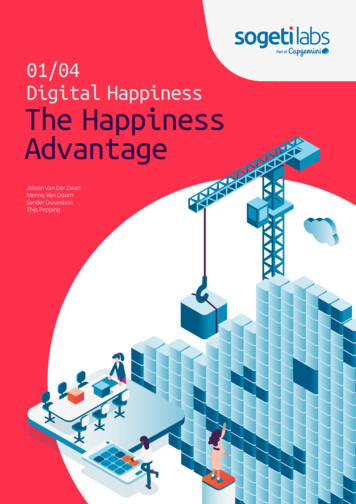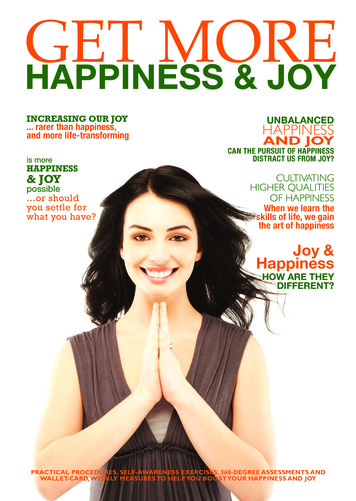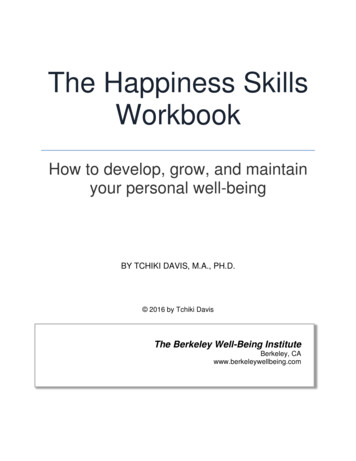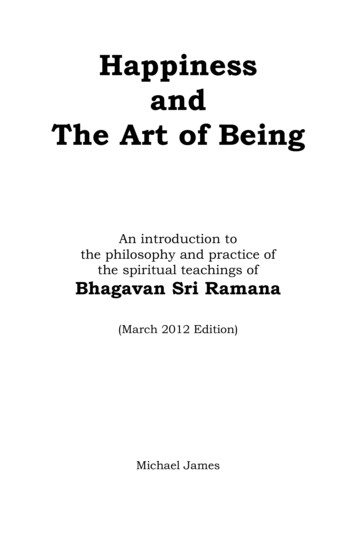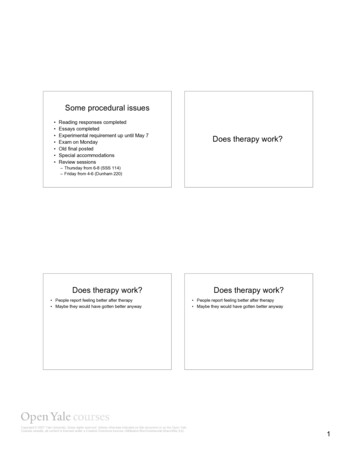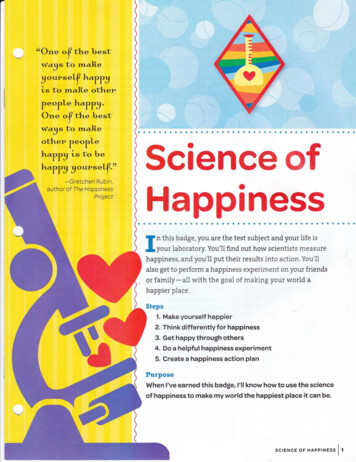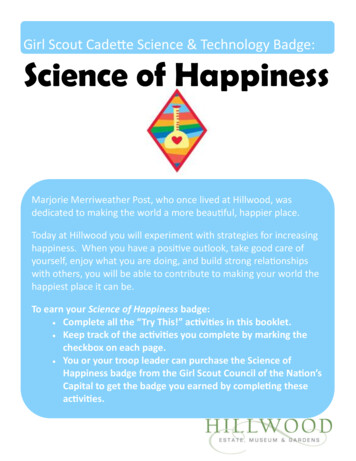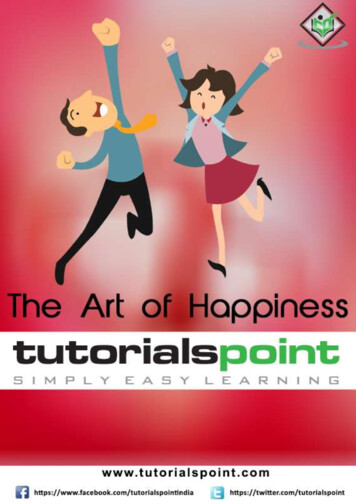
Transcription
The Art of HappinessAbout the TutorialThis tutorial aims to enlighten the learners about the secrets of attaining happiness in life.It is based on the studies done by researchers and scholars at ISB and has been part ofcourse-wares.AudienceThe tutorial will prove useful for all those people who want to seek happiness in life, withoutharboring any prejudice.It is for all those who have resolved to be happy in life, irrespective of age, educationalstatus and financial stature.PrerequisitesThere are no prerequisites for this tutorial. The learner must only be ready to pursuehappiness and shed all kinds of prejudices. However, there is no barrier of language orethnicity for this tutorial.Copyright and Disclaimer Copyright 2016 by Tutorials Point (I) Pvt. Ltd.All the content and graphics published in this e-book are the property of Tutorials Point (I)Pvt. Ltd. The user of this e-book is prohibited to reuse, retain, copy, distribute or republishany contents or a part of contents of this e-book in any manner without written consent ofthe publisher.We strive to update the contents of our website and tutorials as timely and as precisely aspossible, however, the contents may contain inaccuracies or errors. Tutorials Point (I) Pvt.Ltd. provides no guarantee regarding the accuracy, timeliness or completeness of ourwebsite or its contents including this tutorial. If you discover any errors on our website orin this tutorial, please notify us at contact@tutorialspoint.com.i
The Art of HappinessTable of ContentsAbout the Tutorial .iAudience .iPrerequisites .iCopyright and Disclaimer .iTable of Contents . ii1.Happiness — Introduction . 1Importance of Happiness for a Nation . 12.Happiness — Definition . 3What Happiness is Not . 3How to Define Happiness . 43.Happiness — Measuring Happiness . 7Measuring Happiness – On the Subjective Well-being Scale . 7Subjective Well-being Questions . 74.Happiness — Misconceptions . 105.Happiness — The Seven Impediments . 12HAPPINESS – IMPEDIMENT 1 . 146.Happiness — Devaluation . 15Happiness The Happiness Paradox . 167.Happiness — Prioritizing Happiness . 188.Happiness — Pursuing Happiness . 19HAPPINESS – IMPEDIMENT 2 . 209.Happiness — Chasing Superiority . 21Common Traits that Lead to Unhappiness . 21Impact of Pursuing Superiority on Happiness . 2310. Happiness — Pursuing Flow . 25Pursue the Meaning of Life . 25Concept of Flow . 25Features of Flow. 25Conditions to Experience Flow . 26How Flow Works? . 27How to Develop Flow? . 27ii
The Art of Happiness11. Happiness — Self-compassion & Gratitude . 29Need for Self-compassion . 29Gratitude . 30How to Express Gratitude? . 30HAPPINESS – IMPEDIMENT 3 . 3112. Happiness — Craving for Love & Attention. 32Harlow’s Experiment . 32Pain of Rejection . 3213. Happiness — Secure Attachment . 34What is Secure Attachment? . 34Practicing Self-compassion . 35Show Gratitude . 3514. Happiness — To Love and To Give . 36Social Conditions Matter . 3615. Happiness — Creative Altruism . 38HAPPINESS – IMPEDIMENT 4 . 3916. Happiness — Authoritative Nature. 40Why the Love for Authority? . 40Psychological Reactance . 4017. Happiness — Maximizer Scale . 42Why Overly Controlling? . 42Risk-takers and Superstitions . 42The DC Scale . 42Maximizer Scale . 4318. Happiness — Personal Responsibility . 44Control Internal Environment . 44Pessimism. 44Be in Charge of Yourself . 4419. Happiness — Compensatory Forces. 46Being Spiritual Helps . 46Internal Control Improves Relationships . 4720. Happiness — Emotion Regulation Techniques . 4821. Happiness — Appreciating Uncertainty . 50No Uncertainty No Excitement . 50Flow in Uncertainties . 50iii
The Art of Happiness22. Happiness — Maintaining Healthy Lifestyle . 52Eat Healthy . 52Sleep Well . 52Move Your Body . 52Attention Deficit Trait . 53HAPPINESS — IMPEDIMENT 5. 5523. Happiness — Feeling of Distrust . 56Trust Levels and Happiness . 5624. Happiness — Instinctive & Proactive Trust . 57The Problem with Human Instinct . 57Hardwired to Distrust. 57Need to Trust Others . 58Benefits of Proactive Trust . 5825. Happiness — Types of Trust . 59Perceived Trust . 59Actual Trust . 59Which Trust is Higher? . 59The Safe Way to Trust . 60HAPPINESS — IMPEDIMENT 6. 6126. Happiness — Distrusting Life . 6227. Happiness — Preference & Judgmentalism . 6328. Happiness — Suspending Judgement . 64HAPPINESS — IMPEDIMENT 7. 6629. Happiness — Ignoring the Source Within . 67Wandering Mind is a Problem . 67Stay Focused to Stay Happy . 68Benefits of Mindfulness . 68How does Mindfulness Help us to be Happy? . 68Obstacles to Mindfulness . 69iv
1.Happiness — IntroductionThe Art of HappinessBeing happy is one of the most fundamental requirements of a living being. Since thebeginning of the human civilization, man has also been trying to develop new technologies,make new tools and improve his lifestyle for the sole purpose of attaining happiness.However, in its race of scientific endeavor and pursuit of money and luxuries, man is hardlyaware of what exactly constitutes happiness.Happiness is defined as the state in which a living being expresses pleasure andcontentment. It is the state in which negative stress levels are at the lowest, even if notzero and positive stress boosts the person’s positive emotions.Importance of Happiness for a NationHappiness is the purpose behind the functioning of nations and societies at large. Happyindividuals are found to be more successful in their jobs and tend to pass on positive vibesto the people around them.The Gross Domestic Product (GDP) was used to measure the development status of nations.However, these days Happiness Index is catching up as the preferred parameter forjudging the success of a nation. On this scale of Happiness Index, many nations whichranked higher in GDP, scored low on Happiness Index. This shows that all institutions ofmankind are driven by the purpose of achieving happiness in life; schools impart educationfor us to be literate and get a job, meditation centers promise happiness through meditationand hospitals make people happy through successful treatments and so on.1
The Art of HappinessHappiness is a non-tangible entityHappiness is a non-tangible entity that cannot be found in luxuries and riches. Althoughmaterialistic entities can boost our happiness levels, but only for a short-term. It is the stateof mind and our perceptions that shape our idea about happiness and determines ourcontentment level too.Before proceeding with this tutorial, it is very important for the reader to understand thatthere will be tips and techniques which may sound absurd or which may sound conflictingto your goals. However, to attain happiness, the steps mentioned will be necessary.The reader is also expected to find an answer to what he/she wants in life. The tutorialnowhere discourages the readers to renounce the world or not to earn money, but laysdown a plan to focus on the more important aspects in life and to train the mind to focuson them. The tutorial emphasis on changing the common habits developed in one’s life.Here, we will look into all that constitutes real happiness. The chapters will also delve intothe mistakes are committed by people in their attempt to attain happiness and the mythsthat surround the concept of happiness. The tutorial will cover the steps to be happier in lifeand will also cover various techniques to measure progress.2
2.Happiness — DefinitionThe Art of HappinessHappiness is generally defined as the state of mind in which a living being feels pleasureand contentment. However, there is no specific definition for happiness. Happiness is asubjective concept and hence, its definition changes from individual too individual. Forsome, happiness is all about money. For others, it may be just listening to Beethoven’ssonata. For you, it may be reading this tutorial. Hence, everyone has a different definitionof happiness. However, the state of the feeling that one experiences is the same. And hence,the ways to achieve it are more or less common.What Happiness is NotBefore learning what happiness is, it is required to know what it is not. Happiness iscertainly not the following things:Materialistic pleasureIt is always good to cry sitting inside a BMW car, rather than on a cheap bicycle. However,money cannot always buy you happiness. Although money is an elixir for survival in today’smodern world, yet it can buy things but not emotions. What matters is what an individualdoes with the wealth he/she has. The pursuit of money leaves an individual with little timeto enjoy the material pleasures.Feeling Good all the TimeHappy people do not always feel good. It is a misconception that being happy is an eternalstate of mind. Stress, tensions and setbacks are part of life. However, what defineshappiness is how the individual responds to such situations. The capacity to absorb thesetbacks, work on them and improve the condition is what determines happiness levels inthe long-term.One-Stop SolutionPsychologists and counselors advise keeping a diary to boost happiness. Cultivating a hobbywherein, you enter your experiences of each day into your diary or, going for trips orspending quality time with close ones are some of the recommended steps to lead a healthyand happy life. However, most of these habits fade away over time. It is necessary for anindividual to keep adapting to life and keep looking for new ways to be happy.3
The Art of HappinessHow to Define HappinessThe definition of happiness depends on the individual. However, all kinds of happinessstem from the feeling of satisfaction. In the wake of dissatisfaction, an individual ispossessed by the thoughts of the discontent and is occupied by anxiety. Hence, happinessis the state of mind that sets people to have a feeling of positive well-being.The most important task at hand for a person who wants to be happy is to define whathappiness means to him or her. Here is an exercise for you.ExerciseTake a piece of paper and write down your definition of happiness.Now, if you have written down your definition of happiness, compare it with the definitionsgiven over the Internet. You will find a hundred definitions, all differing from one another insome or the other way. However, each definition is correct and is based on the perceptionof the writer.For you, happiness may be the feeling of eternal bliss. For others, it can be as simple asplaying a violin or going for a walk. For some, it can be doing workout, for others it can bewatching one’s favorite movie with friends or alone. This is an important task and must bedone prior to taking any step to be happy.4
The Art of HappinessDefining happiness helps one to measure happiness. Please note, we are not talking ofmonitoring happiness. It is just about measuring happiness, and we will know more aboutthe ways of measurement in the later chapters. There are primarily five ways in whichpeople define happiness. They are as follows: Sensory pleasure Hubristic pride Authentic pride Love or Connection AbundanceSensorypleasureAbundanceLove orconnectionHubristicprideAuthenticprideSensory PleasureIn the first category, people define happiness as moments of sensory pleasure. Going toparties or watching movies or having a night in the arms of one’s love, going on vacationsor having a good food are all included in this category.Hubristic prideHubristic pride is the emotion that one feels when one has a feeling of being superior tosomeone else. For example, winning a contest or a race, winning over an argument, orbeing promoted in office are examples of hubristic pride.5
The Art of HappinessAuthentic prideAuthentic pride is the one that we feel when we find we are at a better position than before.Happiness equals progressing towards mastery of something. We compare to how we wereearlier and how we are now.Love or ConnectionThe fourth category is the emotion felt when we feel in love with something. This ‘something’can be a person or a pet or even an activity or scenery.AbundanceThe last one is the state when a person feels that he/she is happy with what life is like.Abundance is felt when we find life as interesting and not threatening.The best definitions are the ones which have elements of authentic pride, love or abundance.Hubristic pride does not last longer and is also not a good quality to possess. Sensorypleasure is also distracting and transient.The best definition of happiness is the one which is based on abundance. The reason beingthat abundance is found to last longer than all others. Happiness can be believed as joy.Happiness can be also defined as a feeling of serenity. It can be also defined as a feeling ofinterest or curiosity. Another way to see happiness is to see it as a feeling of amusement orlaughter.6
3.Happiness — Measuring HappinessThe Art of HappinessMeasuring Happiness – On the Subjective Well-being ScaleIt is very important to measure one’s happiness. Without proper measurement, it is almostimpossible to determine if one is getting happier in life or not. Everyone has a different wayto measure happiness. However, in this tutorial, we will delve into the Subjective Well-beingScale devised by Ed Diener, an American psychologist, professor and an author.Before looking into the subjective well-being scale, it is important to understand whatsubjective well-being means. Subjective well-being refers to how people experience thequality of their lives. It includes cognitive judgments and emotional reactions tosituations. A number of psychologists have defined happiness as the combination of lifesatisfaction and the relative frequency of positive and negative effects. The cognitive aspectsinvolve evaluations of one’s life, satisfaction etc.Subjective Well-being QuestionsSubjective well-being questions are not entirely subjective as the questions are selfreported. However, the questions ask the respondents to rate their feelings, rather thanrecall factual information and this is what makes the questions somewhat subjective.Objective indicators instead use parameters like educational level, health standards andemployment condition to determine happiness. However, objective questions do not takeinto account the human perception. But human perception is regarded as the central figurein the well-being of an individual. The reason is that the only person who knows whether anindividual is feeling low or high is the individual himself.There are three approaches to determine subjective well-being of a person: Evaluative Experience Eudemonic7
The Art of HappinessEvaluativeIn the evaluative approach, a person is required to make a cognitive reflection of his life.The respondents are asked to appraise their life on the parameters of health, job,educational qualifications, relationships etc. In addition to this, Cantril Ladder is also used.The respondents are asked to rate their life on a scale of 0 to 10.ExperienceThe approach of experience aims to assess the emotional quality of a person’s experience.The factors like frequency, intensity and the kind of effect at any moment is used in thisapproach. The methods like Day Reconstruction Method (DRM) and ExperienceSampling Method (ESM) are also used to record the mood and well-being of a personthroughout the day across various activities.EudemonicThe eudemonic approach has its foundation in the belief that each individual has underlyingpsychological needs to add meaning to one’s life. The factors included in this approachinclude autonomy, relationships, engagement, control, competence, purpose andachievement among many others.8
The Art of HappinessThe Satisfaction with Life Scale (SLWS) is the scale we will use at the beginning of thistutorial. Here is a small exercise. Ask yourself the following questions and rate on the scaleof 1-7. In most ways, my life is close to my ideal. The conditions of my life are excellent. I am satisfied with my life. So far, I have gotten the important things I want in life. If I could turn back on time, I would change almost nothing.The scores that you provide would mean the following: 7 - Strongly agree 6 - Agree 5 - Slightly agree 4 - Neither agree nor disagree 3 - Slightly disagree 2 - Disagree 1 - Strongly disagreeAdd all the scores and tally the sum with the explanations given for each score below. 31 – 35: Extremely satisfied 26 – 30: Satisfied 21 – 25: Slightly satisfied 20: Neutral 15 – 19: Slightly dissatisfied 10 – 14: Dissatisfied 5–9Extremely dissatisfiedThis is how subjective well-being is measured. It helps you to determine how happy you arein life and helps the psychologists to measure others’ happiness levels. Although not afoolproof method, yet this scale is widely used these days.9
4.Happiness — MisconceptionsThe Art of HappinessHappiness is so much wanted by everyone that it is natural for people to developmisconceptions about it. Happiness is not always what we think of what it is because ourperceptions and experiences with the world mold our opinion of happiness and at times, wedevelop delusions regarding happiness. Let us now go through the common fallacies thatman has with regards to the concept of happiness.Misconception 1: Suppressing negative emotionsHappiness is certainly not about suppressing one’s emotions, especially the negative ones.Happier people on the earth are as vulnerable to sad moments and moments ofdejection and grief as anyone else in the world is. However, what matters is what a persondoes with those moments and how he or she responds to them that defines happiness levels.Happier people have been found to focus more on the solutions, rather than the problemand this is what makes them happier than others. If an individual tries to suppress hisnegative emotions, those emotions will keep eating him and hollowing him from inside. Thehappier people allow themselves to feel sad at times, so that all the negative feelings canbe let out. It is also okay to cry at times. However, once the negative phase has passed,the happier people focus on the next steps to be taken to address the situation, rather thanjust lamenting over what has happened.Misconception 2: Happiness is all about goalsIt is a common adage that the ‘journey matters more than the destination’. It is importantto have goals in life. However, goals are not the only things that make us happy. End isimportant, but means are even more important. Only accomplishment of goals doesnot make an individual happy.Most of the people in the world think that once goals are achieve
The Art of Happiness 3 Happiness is generally defined as the state of mind in which a living being feels pleasure and contentment. However, there is no specific definition for happiness. Happiness is a subjective concept and hence, its definition changes from individua
